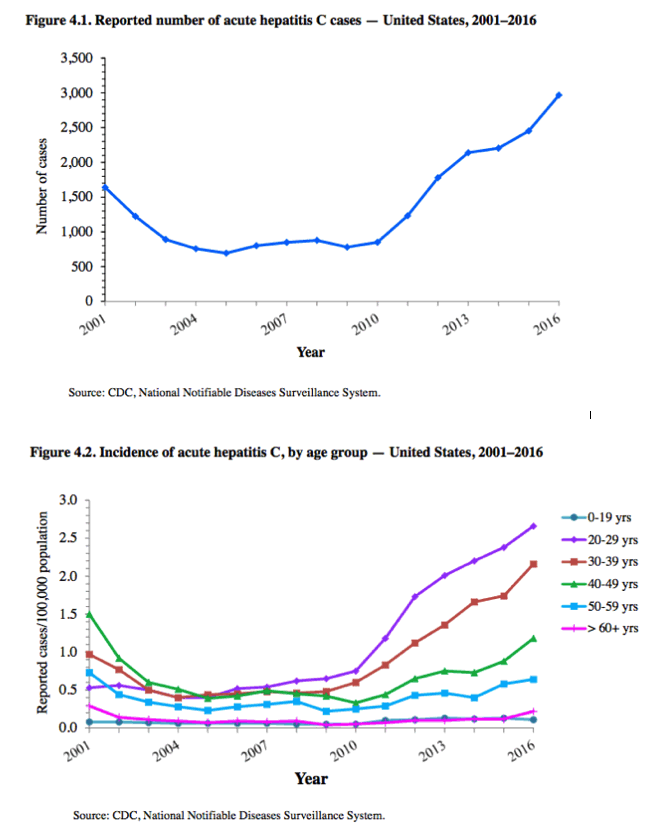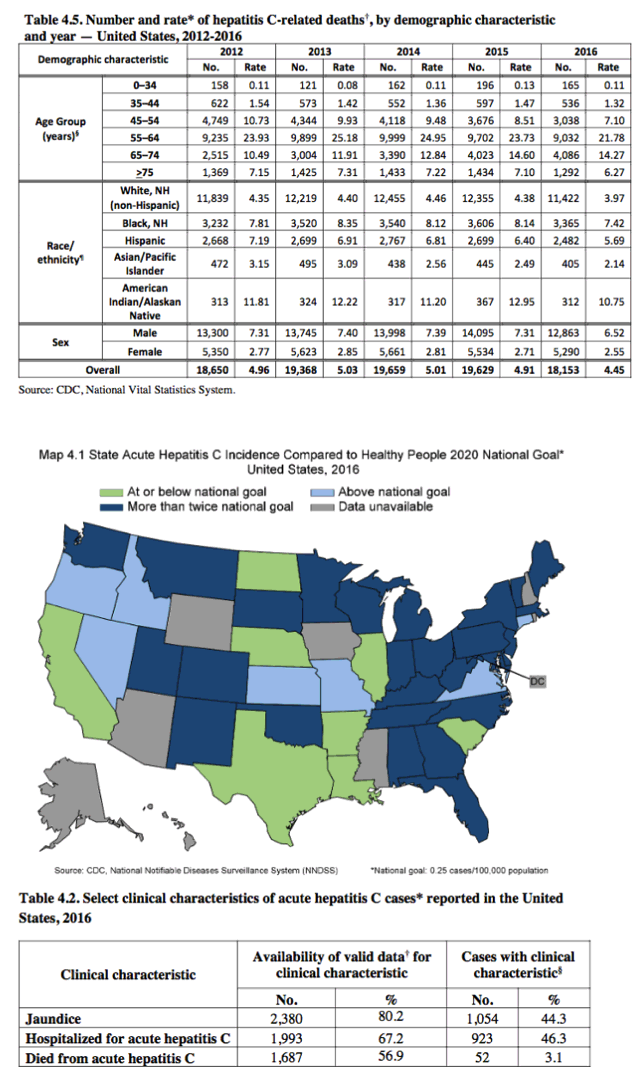| |
|
CDC- HCV Increased New Cases: increased about 3.5-fold from 2010 through 2016; increased 21.8% to 2,967 cases in 2016
|
| |
| |
April 03, 2018
https://www.cdc.gov/hepatitis/statistics/2016surveillance/commentary.htm
Full PDF report -
https://www.cdc.gov/hepatitis/statistics/2016surveillance/pdfs/2016HepSurveillanceRpt.pdf
from Jules: the level of funding for CDC viral hepatitis from Congress is an embarrassing $39 million and has remained sat round this low level for years. $1 Billion is needed to provide reasonable funding amounts to states for screening, linkage to care and care support services. HCV is curable with current cure rates of 97%-100% in recent phase 3 studies for new HCV drugs, so HCV could be eliminated if federal officials and congress decided to do this but they do not want to.
Hepatitis C: Reported cases of acute hepatitis C virus (HCV) infection increased about 3.5-fold from 2010 through 2016 (from 850 to 2,967 reported cases), rising annually throughout this period. Examining annual trends beginning in 2012, reported cases of acute HCV infection increased 20.2% from 2012 to 2013 (n=1,778 and 2,138 cases, respectively), increased 2.6% to 2,194 cases in 2014, increased 11.0% to 2,436 cases in 2015, and increased 21.8% to 2,967 cases in 2016. The increase in acute HCV case reports reflects new infections associated with rising rates of injection-drug use, and, to a lesser extent, improved case detection (13, 14). Several early investigations of newly acquired HCV infections reveal that most occur among young, white persons who inject drugs and live in non-urban areas (particularly in states within the Appalachian, Midwestern, and New England regions of the country) (14, 15); trends in these states likely indicate an overall increase in HCV incidence throughout the country (13, 16). The great majority of acute HCV are not reported as few adults and adolescents with HCV have symptoms, and only a minority of them are then diagnosed and reported to health authorities. After adjusting for under-ascertainment and under-reporting (2), an estimated 41,200 (95% CI, 32,600-140,600) new HCV infections occurred in 2016.
Based on the data from national health surveys conducted during 2003-2010 and adjusted for underreporting, approximately 3.5 million persons were infected with HCV (17). This prevalence estimate reflects changes in HCV incidence, cures of HCV infections, and mortality from HCV and other causes. Mortality among HCV-infected persons-primarily adults aged 55-64 years-increased during 2006-2010 (18, 19). In 2013, HCV-related deaths, as recorded on death certificates, exceeded the combined number of deaths of 60 other infectious diseases as underlying or contributing causes (20). The overall hepatitis C-related mortality rate remained steady from 2012 through 2014 (5.0 deaths/100,000 population); it then declined to 4.9 deaths/100,000 in 2015 and declined still further to 4.5 deaths/100,000 in 2016. However, some evidence suggests that deaths in HCV-infected persons may have been under enumerated (18); the only large U.S. study of deaths among persons with confirmed HCV infection indicated that only 19% had HCV listed anywhere on the death certificate despite 75% having evidence of substantial liver disease (19). With current treatment regimens, over 90% of HCV infected persons can be cured of HCV infection with an 8-12 week oral therapy (21). To increase the proportion of persons with HCV who are tested and linked to recommended care including curative treatment for HCV (12, 22), CDC and USPSTF recommend one-time testing for HCV infection among all adults born during 1945-1965 and among others at increased risk for HCV infection (23).


| |
| |
| |
|
|
|